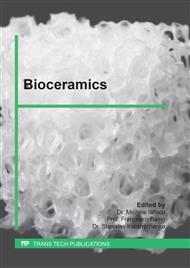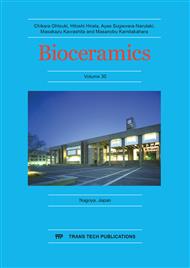[1]
Farré-Guasch E, Prins H J, Overman J R, et al. Human Maxillary Sinus Floor Elevation as a Model for Bone Regeneration Enabling the Application of One-Step Surgical Procedures J. Tissue Engineering Part B Reviews, 2013, 19(1):69-82.
DOI: 10.1089/ten.teb.2012.0404
Google Scholar
[2]
Wang M. Materials Selection and Scaffold Fabrication for Tissue Engineering in Orthopaedics J. 2007:259-288.
Google Scholar
[3]
Kimura Y, Ozeki M, Inamoto T, et al. Adipose tissue engineering based on human preadipocytes combined with gelatin microspheres containing basic fibroblast growth factor J. Biomaterials, 2003, 24(14):2513-2521.
DOI: 10.1016/s0142-9612(03)00049-8
Google Scholar
[4]
Chong E J, Phan T T, Lim I J, et al. Evaluation of electrospun PCL/gelatin nanofibrous scaffold for wound healing and layered dermal reconstitution J. Acta Biomaterialia, 2007, 3(3):321-330.
DOI: 10.1016/j.actbio.2007.01.002
Google Scholar
[5]
Lin C L, Lin C H, Chang H C, et al. Protein Attachment on Nanodiamonds J. Journal of Physical Chemistry A, 2015,119(28):7704.
Google Scholar
[6]
Bhatnagar P, Pant A B, Shukla Y, et al. Hyaluronic acid grafted PLGA copolymer nanoparticles enhance the targeted delivery of Bromelain in Ehrlich's Ascites Carcinoma J. European Journal of Pharmaceutics & Biopharmaceutics, 2016, 105:176-192.
DOI: 10.1016/j.ejpb.2016.06.002
Google Scholar
[7]
Correia C, Moreirateixeira L S, Moroni L, et al. Chitosan scaffolds containing hyaluronic acid for cartilage tissue engineering J. Tissue Eng Part C Methods, 2011, 17(7):717-730.
DOI: 10.1089/ten.tea.2010.0467
Google Scholar
[8]
Shavandi A, Ael-D B, Ali M A, et al. Development and characterization of hydroxyapatite/β-TCP/chitosan composites for tissue engineering applications J. Materials Science & Engineering C Materials for Biological Applications, 2015, 56:481–493.
DOI: 10.1016/j.msec.2015.07.004
Google Scholar
[9]
Zhang M, Wang K, Shi Z, et al. Osteogenesis of the construct combined BMSCs with β-TCP in rat J. Journal of Plastic Reconstructive & Aesthetic Surgery Jpras, 2009, 63(2):227-232.
DOI: 10.1016/j.bjps.2008.11.017
Google Scholar
[10]
Hong Y, Fan H, Li B, et al. Fabrication, biological effects, and medical applications of calcium phosphate nano ceramics J. Materials Science & Engineering R Reports, 2010, 70(3):225-242.
DOI: 10.1016/j.mser.2010.06.010
Google Scholar
[11]
Chang K H, Liao H T, Chen J P. Preparation and characterization of gelatin/hyaluronic acid cryogels for adipose tissue engineering: in vitro and in vivo studies J. Acta Biomaterialia, 2013, 9(11):9012-9026.
DOI: 10.1016/j.actbio.2013.06.046
Google Scholar
[12]
Zhang F, He C, Cao L, et al. Fabrication of gelatin–hyaluronic acid hybrid scaffolds with tunable porous structures for soft tissue engineering J. International Journal of Biological Macromolecules, 2011, 48(3):474-81.
DOI: 10.1016/j.ijbiomac.2011.01.012
Google Scholar
[13]
Wang H, Feng Y, Fang Z, et al. Fabrication and characterization of electrospun gelatin-heparin nanofibers as vascular tissue engineering J. Macromolecular Research, 2013, 21(8):860-869.
DOI: 10.1007/s13233-013-1105-7
Google Scholar
[14]
Gutiérrez M, García-Carvajal Z, Jobbágy M, et al. Poly(vinyl alcohol) Scaffolds with Tailored Morphologies for Drug Delivery and Controlled Release J. Advanced Functional Materials, 2010, 17(17):3505-3513.
DOI: 10.1002/adfm.200700093
Google Scholar
[15]
Wang T W, Spector M. Development of hyaluronic acid-based scaffolds for brain tissue engineering J. Acta Biomaterialia , 2009, 5(7):2371-2384.
DOI: 10.1016/j.actbio.2009.03.033
Google Scholar
[16]
Yun H L, Lee J H, An I G, et al. Electrospun dual-porosity structure and biodegradation morphology of Montmorillonite reinforced PLLA nanocomposite scaffolds J. Biomaterials, 2005, 26(16):3165-3172.
DOI: 10.1016/j.biomaterials.2004.08.018
Google Scholar
[17]
Cooper J A, Lu H H, Ko F K, et al. Fiber-based tissue-engineered scaffold for ligament replacement:design consideration and in vitro evaluation J. Biomaterials, 2005, 26(13):1523-1532.
DOI: 10.1016/j.biomaterials.2004.05.014
Google Scholar



